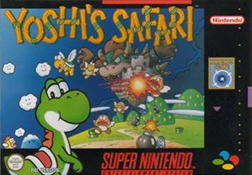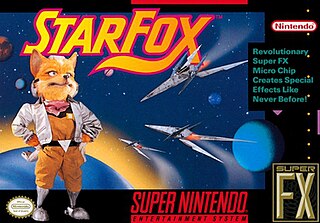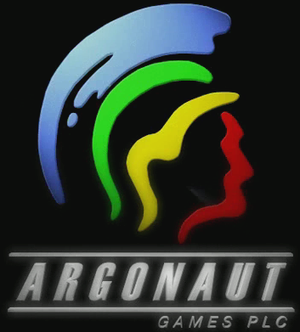
Super Mario World 2: Yoshi's Island is a 1995 platform game developed and published by Nintendo for the Super Nintendo Entertainment System (SNES). It is the sequel follow-up to Super Mario World. The player controls Yoshi, a friendly dinosaur, on a quest to reunite baby Mario with his brother Luigi, who has been kidnapped by Kamek. As a Super Mario series platformer, Yoshi runs and jumps to reach the end of the level while solving puzzles and collecting items with Mario's help. The game has a hand-drawn aesthetic and was the first in the franchise to have Yoshi as its main character, where it introduces his signature flutter jump and egg spawning abilities.

Donkey Kong Country is a 1994 platform game developed by Rare and published by Nintendo for the Super Nintendo Entertainment System (SNES). It is a reboot of Nintendo's Donkey Kong franchise and follows the gorilla Donkey Kong and his nephew Diddy Kong as they set out to recover their stolen banana hoard from the crocodile King K. Rool and his army, the Kremlings. The single-player traverses 40 side-scrolling levels as they jump between platforms and avoid obstacles. They collect items, ride minecarts and animals, defeat enemies and bosses, and find secret bonus stages. In multiplayer modes, two players work cooperatively or race each other.

Donkey Kong Land is a 1995 platform game developed by Rare and published by Nintendo for the Game Boy. It condenses the side-scrolling gameplay of the Super Nintendo Entertainment System (SNES) game Donkey Kong Country (1994) for the handheld Game Boy with different level design and boss fights. The player controls the gorilla Donkey Kong and his nephew Diddy Kong as they defeat enemies and collect items across 30 levels to recover their stolen banana hoard from the crocodile King K. Rool.
Star Fox is an arcade style rail shooter and third person action-adventure video game series created by Shigeru Miyamoto, produced and published by Nintendo. The games follow the Star Fox combat team of anthropomorphic animals, led by chief protagonist Fox McCloud. Gameplay involves many adventures around the Lylat planetary system in the futuristic Arwing fighter aircraft, in other vehicles, and on foot. The original Star Fox (1993) is a forward-scrolling 3D rail shooter, but later games add more directional freedom.

Yoshi's Safari is a 1993 light gun shooter developed and published by Nintendo for its Super Nintendo Entertainment System (SNES). It is the only Mario franchise game to feature first-person shooter gameplay and requires the SNES's Super Scope light gun. As Mario and his pet dinosaur Yoshi, the player embarks on a quest to save the kingdom of Jewelry Land from Bowser and his Koopalings, who have kidnapped its rulers and stolen 12 gems. The game features 12 levels in which the player shoots enemies like Goombas and Koopas, and collects power-ups and coins. At the end of each level, the player engages in a boss fight with an enemy, a Koopaling, or Bowser. Nintendo commissioned its R&D1 department to develop Yoshi's Safari in response to the waning popularity of the Super Scope. Yoshi's Safari was the first Super Scope title to use the SNES's Mode 7 graphics mode, and the future of the peripheral depended on the game's performance.

Star Fox, known as Starwing in PAL regions, is a rail shooter video game developed by Nintendo and Argonaut Software, and published by Nintendo for the Super Nintendo Entertainment System. The first game in the Star Fox series, the story follows Fox McCloud and the rest of the Star Fox team defending their homeworld of Corneria against the invading forces of Andross.

Star Fox 2 is a rail shooter video game developed by Nintendo and Argonaut Software and published by Nintendo. Originally developed for the Super Nintendo Entertainment System, it was completed in 1995 but did not see an official release until 2017 on the Super NES Classic Edition.

Argonaut Games PLC was a British video game developer founded in 1982. It was known for the Super NES video game Star Fox and its supporting Super FX chip, and for Croc: Legend of the Gobbos and the Starglider series. The company was liquidated in late 2004, and ceased to exist in early 2007.

The Super FX is a coprocessor on the Graphics Support Unit (GSU) added to select Super Nintendo Entertainment System (SNES) video game cartridges, primarily to facilitate advanced 2D and 3D graphics. The Super FX chip was designed by Argonaut Games, who also co-developed the 3D space rail shooter video game Star Fox with Nintendo to demonstrate the additional polygon rendering capabilities that the chip had introduced to the SNES.

Stunt Race FX, known in Japan as Wild Trax, is a racing video game developed by Nintendo and Argonaut Software and published by Nintendo for the Super Nintendo Entertainment System. It is the second game to use the 3D-centric Super FX powered GSU-1.

Metal Combat: Falcon's Revenge is a light gun shooter video game developed by Nintendo and Intelligent Systems and published by Nintendo for the Super Nintendo Entertainment System in 1993. It is the sequel to Battle Clash and like its predecessor, it requires the use of the Super Scope peripheral in order to be played.

Dragon View is a side-scrolling role-playing beat 'em up for the Super Nintendo Entertainment System developed by Kotobuki System in November 1994 and published by Kemco in North America. Released in Japan as Super Drakkhen and otherwise known as Drakkhen II, it is meant to be a sequel to Drakkhen although it bears little resemblance to its predecessor. It uses the same pseudo-3D overworld system for which the series is most famous. Other features of Dragon View are its side-view action role-playing game (RPG) hybrid gameplay, its well translated first-person storyline, and its emphasis on player-driven undirected exploration. In 2019, the game was re-released through emulation for Windows. In 2022, a reproduction SNES cartridge was released by Limited Run Games.

Super Ghouls 'n Ghosts, known as Chou Makaimura in Japan, is a platform video game developed and published by Capcom for the Super Nintendo Entertainment System in 1991. As the third game in the Ghosts 'n Goblins series and the first not to be released for the arcade, it again depicts knight Arthur saving Princess Guinevere and the kingdom from Emperor Sardius, who has cast a spell that has revived the Ghoul Realm.
FX Fighter is a series of video games developed by Argonaut Software and published by GTE Entertainment. The two games in the series are FX Fighter (1995) for DOS CD-ROM and FX Fighter Turbo (1996) for Windows 95.

Starglider is a 3D video game published in 1986 by Rainbird. It was developed by Jez San under his company name Argonaut Software. The game is a fast-moving, first-person combat flight simulator, rendered with colourful wireframe vector graphics inspired by San's love of the 1983 Atari coin-op Star Wars.

Dirt Trax FX is a racing video game developed by Sculptured Software and released by Acclaim Entertainment for the Super Nintendo Entertainment System in 1995. The 3D graphics of the game were made possible by the Super FX powered GSU-1, which was built into the cartridge.

Waterworld is a series of video games released for the Super Nintendo Entertainment System, Virtual Boy, MS-DOS, Microsoft Windows and Game Boy, based on the film of the same name, along with unpublished versions for the Mega Drive/Genesis, Sega Saturn, Atari Jaguar, 3DO and PlayStation. These games were produced by Ocean Software. The SNES and Game Boy games were released only in Europe in 1995 and the Virtual Boy game was released exclusively in North America in November 1995. It was released for PC in 1997. The game received widespread negative reviews and the version released for the Virtual Boy is generally considered to be the worst game of its 22 releases.

Fever Pitch Soccer, known as Head-On Soccer in North America, is a soccer video game originally developed and published by U.S. Gold for the Sega Genesis/Mega Drive in 1995.

Dragon Ball Z: Hyper Dimension is a 1996 fighting video game developed by Tose and published by Bandai for the Super Nintendo Entertainment System. Based upon Akira Toriyama's Dragon Ball franchise, it is the last fighting game in the series to be released for SNES. Following from the Frieza saga to the conclusion of the Majin Buu saga, its gameplay is similar to the earlier Butōden entries, consisting of one-on-one fights using a main six-button configuration, featuring special moves as well as multiple game modes.


















